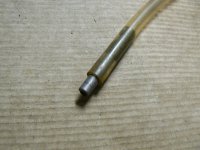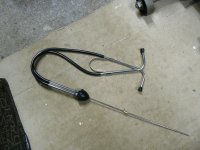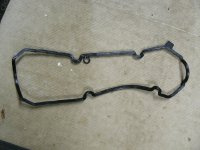Hello.
So do I understand you correctly that the ticking is there most of the time? If so this sounds like a candidate for a "listening tube". Get yourself a length of flexible tubing, mine is 8mm bore and about 4 ft long (for no really good reason, it just needs to be long enough to reach bits of the engine and this was a bit that was lying about the workshop when I needed it). Stick one end in your ear and move the other end around near the engine until the noise is loudest. Then you will know exactly where it's coming from and you can make a more educated diagnosis of the likely culprit. Of course be very careful not to get it tangled up in any drive belts or fan blades etc.
I also find a "listening stick" can be very useful. A nice long thin screwdriver is my favourite choice for this. To use, place the metal tip of the blade against the component you suspect is making the noise and use the handle - cleaned with a wipe first perhaps? - to close off your ear channel. You'll find it magnifies the noise and it's really loud when you have that tip against the offending component. I like to use this for checking out something like a noisy alternator bearing, water pump bearing, idler bearing, etc. The tube can be better at listening for inlet/exhaust manifold gasket and joint leaks, turbo pipe leakes, breather pipes, etc.
Be careful when using the screwdriver because with it stuck in your ear you can't see what's happening to the "business end" and if it slips it could easily get caught up in a drive belt etc, with painful results - That's why I say to place the end of the blade against the component first. Here's a picture of my "listening tube" and favourite "listening stick":

You can probably see that the tube has a piece of metal pipe stuck up it's business end:

and there's a good reason for this. You put the soft end in your ear of course - I find that if you get roughly into the right area for the noise you can sometimes narrow things down even more by touching the metal pipe to the component part where you suspect the noise is coming from and get an even better diagnosis. A "listening stick" is better but with the bit of metal pipe I can often confirm a suspicion quickly without needing to get the screwdriver from my tool box.
I was shown these diagnostic aids by one of the old hands in the workshop very early on in my working life and still use them to this day. However a few years ago I bought myself a "proper" mechanics acoustic stethoscope:

It works by placing the earpieces in your ears and touching the end of the long solid probe to the component you suspect. Just as you would use the "listening stick" screwdriver, makes you look impressively "medical". It works well enough and has the advantage you can see where you are placing the probe, but it's no better than the screwdriver at letting you hear the noises. I tend to only bring it out when I particularly want to impress someone!
As an example of one of the surprising things I found out by using the listening tube hows about this. When I bought our 1.2 2010 Panda 1.2 8 valve - so almost the same engine as yours but no VVT pulley - it was making a small noise which sounded to me like a slightly worn idler bearing. One of the first jobs I did was to replace the timing belt, idler and water pump expecting the noise to go away. It didn't! I left the belt guards off and, with the engine running, I used the screwdriver to go round all the "usual suspects" - idler, Water pump, Alternator, aircon pump, etc but all were fine So, although I would have sworn it was a bearing making the noise, I broke out the tube . It was loudest whenever I went near the camshaft pulley which surprised me as there are no ball or roller races in that area - and the noise sounded like a worn ball race. I very carefully moved the end of the tube around a little bit at a time and it was loudest when the end of the tube was hovering over where the teeth on the belt mesh into the cam pulley teeth - about 8 o'clock on the cam pulley if you think of it as a clock face. The noise is made by the meshing of the belt's teeth with the top pulley teeth! I've now mentioned it to a couple of chaps I know who work in garage workshops and they say "yes, some do it and some don't but it's not unusual, the Fords with this engine do it too" No-one I spoke to could tell me exactly what caused it and were interested in what I had to say. I've since double checked after the belt had settled in for about a year and I'm absolutely certain the noise is produced as I've said above. There's one that "lives" about half a mile away from me which does it but I haven't the courage to ask if I could "check it out".
Here's a wee "stab in the dark" diagnostic for you regarding your clicking. Do you know if they removed the cam cover when they changed the belt? You have to do this if you are going to use the recommended locking tools on the camshaft. Some people/workshops do not do this but will mark up the belt and pulleys (typically with tippex), transfer the markings to the new belt and fit it by lining up the marks. It's not the recommended or most accurate way to do it but it can work well if you are careful and experienced and, most importantly from the money point of view, it saves a shed load of time because you don't remove the cam cover. What's going through my mind is that the oil supply to the cam, tappets and VVT pulley travels through drillings in the cam cover there are rubber "O" ring seals in the cam cover which seal against the top of the cam journal castings? (for want of a better description) These O rings will usually stay in the cam cover when it's removed - they fit into machined "grooves" but I suppose one might fall out when the cover is inverted? Should this happen and the cover was fitted with one missing (there are 3 for the journals and one for the VVT supply) I would imagine much less oil would be finding it's way to the tappets nearest to that journal and so they might "click" because they are not being bathed in a flow of oil? Actually I think this is a pretty long shot, but if nothing else has been found it might be worth whipping the cover off and having a look as it's a pretty simple thing to do? Assuming of course that they did remove the cover when they did the job?






